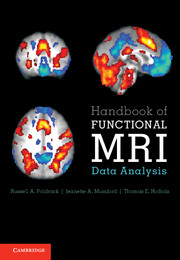Book contents
- Frontmatter
- Contents
- Preface
- 1 Introduction
- 2 Image processing basics
- 3 Preprocessing fMRI data
- 4 Spatial normalization
- 5 Statistical modeling: Single subject analysis
- 6 Statistical modeling: Group analysis
- 7 Statistical inference on images
- 8 Modeling brain connectivity
- 9 Multivoxel pattern analysis and machine learning
- 10 Visualizing, localizing, and reporting fMRI data
- Appendix A A Review of the General Linear Model
- Appendix B Data organization and management
- Appendix C Image formats
- Bibliography
- Index
1 - Introduction
Published online by Cambridge University Press: 01 June 2011
- Frontmatter
- Contents
- Preface
- 1 Introduction
- 2 Image processing basics
- 3 Preprocessing fMRI data
- 4 Spatial normalization
- 5 Statistical modeling: Single subject analysis
- 6 Statistical modeling: Group analysis
- 7 Statistical inference on images
- 8 Modeling brain connectivity
- 9 Multivoxel pattern analysis and machine learning
- 10 Visualizing, localizing, and reporting fMRI data
- Appendix A A Review of the General Linear Model
- Appendix B Data organization and management
- Appendix C Image formats
- Bibliography
- Index
Summary
The goal of this book is to provide the reader with a solid background in the techniques used for processing and analysis of functional magnetic resonance imaging (fMRI) data.
A brief overview of fMRI
Since its development in the early 1990s, fMRI has taken the scientific world by storm. This growth is easy to see from the plot of the number of papers that mention the technique in the PubMed database of biomedical literature, shown in Figure 1.1. Back in 1996 it was possible to sit down and read the entirety of the fMRI literature in a week, whereas now it is barely feasible to read all of the fMRI papers that were published in the previous week! The reason for this explosion in interest is that fMRI provides an unprecedented ability to safely and noninvasively image brain activity with very good spatial resolution and relatively good temporal resolution compared to previous methods such as positron emission tomography (PET).
Blood flow and neuronal activity
The most common method of fMRI takes advantage of the fact that when neurons in the brain become active, the amount of blood flowing through that area is increased. This phenomenon has been known for more than 100 years, though the mechanisms that cause it remain only partly understood. What is particularly interesting is that the amount of blood that is sent to the area is more than is needed to replenish the oxygen that is used by the activity of the cells.
- Type
- Chapter
- Information
- Handbook of Functional MRI Data Analysis , pp. 1 - 12Publisher: Cambridge University PressPrint publication year: 2011
- 1
- Cited by



